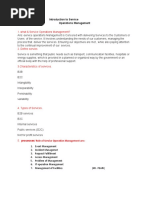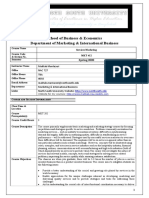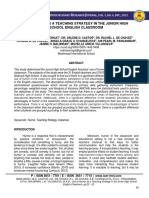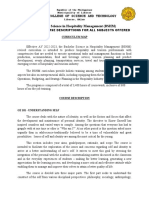Syllabus
Uploaded by
Diksha NasaSyllabus
Uploaded by
Diksha NasaSEMESTER - VII
Course Course Course L T P C
18MBH463J SERVICES SCIENCE AND SERVICE OPERATIONAL MANAGEMENT C Humanities & Social Sciences
Code Name Category 3 0 2 4
Pre-requisite Co-requisite Progressive
Nil Nil Nil
Courses Courses Courses
Course Offering Department College of Management Data Book / Codes/Standards Nil
Course Learning Rationale (CLR): The purpose of learning this course is to: Learning Program Learning Outcomes (PLO)
CLR-1 : Define the differences between goods and services 1 2 3 1 2 3 4 5 6 7 8 9 10 11 12 13 14 15
CLR-2 : Discuss characteristics of services
Level of Thinking (Bloom)
Expected Proficiency (%)
Expected Attainment (%)
Individual & Team Work
Engineering Knowledge
Design & Development
Project Mgt. & Finance
CLR-3 : Analyse services design concepts and evaluate them
Modern Tool Usage
CLR-4 : Discuss methods to manage Service business
Life Long Learning
Society & Culture
Problem Analysis
Analysis, Design,
CLR-5 : Plan innovation in Service
Communication
Environment &
Sustainability
CLR-6 : Incorporate the different types of services and management strategy
Research
PSO – 3
PSO - 1
PSO - 2
Ethics
Course Learning Outcomes (CLO): At the end of this course, learners will be able to:
CLO-1 : Analyse concepts about Services and distinguish it from Goods 3 80 70 M M M M M M - - M M L M - - -
CLO-2 : Identify characteristics and nature of Services 3 85 75 M H L M L - - - M L - H - - -
CLO-3 : Comprehend ways to design Services and evaluate them using Service qualities 3 75 70 M H M H L - - - M L - H - - -
CLO-4 : Apply how various methods can be used to operate and manage Service businesses 3 85 80 M H M H L - - - M L - H - - -
CLO-5 : Explain how innovation can be approached from Services point of view 3 85 75 H H M H L - - - M L - H - - -
CLO-6 : Construct the different types of services and management strategy for them 3 80 70 L H - H L - - - L L - H - - -
Duration
15 15 15 15 15
(hour)
SLO-1 Introduction-Basic Terminology Strategic Service Vision Technology in Service Capacity Planning Management of Service Project
S-1
SLO-2 Service Economy Competitive environment for Services Emergence of Service Encounter Leveling Capacity Service Product Development
SLO-1 Role of Services Competitive Service Strategies Service Encounter Triad Demand Management Project Management
S-2 Encounter Dominated by the Service
SLO-2 Evolution of Economy Strategic Analysis Demand Management Strategies Principles of Project Management
Organization
SLO-1 Nature of Service Sector Service Benchmarking Contact Personnel–Dominated Encounter Customer-Induced Variability Project Management Process
S-3
SLO-2 Differences between Goods and Services Service Innovation Customer-Dominated Encounter Segmenting Demand Triple Objectives
S SLO-1 Experience Economy Offering Price Incentives/ Promoting Off-
New Service Development. Service Organization Elements Project Team/ Project Leadership
4-5 SLO-2 Service Dominant Logic Peak Demand
SLO-1 Characteristics of Service Operations Service System Design Service Control Systems Developing Complementary Services Project Management Techniques
S-6
SLO-2 Complexity – Customer Participation Approaches for Service Design Contact Personnel management Reservation Systems and Overbooking Objectives of Project Management
SLO-1 Simultaneity and its consequences Service Quality Customer Expectations Strategies for Managing Capacity Gantt Charts
S-7
SLO-2 Perishability SERVQUAL Creating Customer Orientation Defining Service Capacity Pros and Cons of Gantt charts
S-8 SLO-1 Intangibility Walk Through Audits Service Profit chain Daily Workshift Scheduling Project network
SRM Institute of Science & Technology – Academic Curricula (2018 Regulations)
134
Duration
15 15 15 15 15
(hour)
SLO-2 Heterogeneity Quality by Design Facility Design Daily Workshift with constraints Critical Path Method
S SLO-1 Non Transference of Ownership
Strategic Positioning Process Analysis Increasing Customer Participation Resource Constraints
9-10 SLO-2 Outcomes of complexity
SLO-1 Pre-industrial Economy Service Blueprint Facility layout Creating Adjustable Capacity Activity Crashing
S-11
SLO-2 Industrial Economy Taxonomy of Service Process Environment Orientation Sharing Capacity Activity Crashing tools
SLO-1 Post-Industrial Economy Degree of Divergence Process Improvement Yield Management Uncertainty in Activity duration
S-12
SLO-2 Evolution and Innovation Object of Service Process Queue analysis Productivity/ Part time Employees PERT
SLO-1 Value co-creation Customer Contact types Queue Applications Waiting Line Management Issues in CPM
S-13
SLO-2 Service Encounters Information Empowerment Service Productivity Service Level Issues in PERT
S SLO-1 Service Package
Customer Centric approaches Quality Tools Demand Forecasting Project Monitoring techniques
14-15 SLO-2 Grouping by Delivery Processes
1. Fitzsimmons & Fitzsimmons, Service Management: Operations, Strategy, Information
4. Reason, Ben, and Lovlie, Lavrans, (2016) Service Design for Business: A Practical Guide to Optimizing the
Technology, McGraw Hill publications (9th edition), 2019
Learning Customer Experience, Pan Macmillan India
2. Wilson, A., Zeithaml, V. A., Bitner, M. J., & Gremler, D. D. (2012). Services marketing:
Resources 5. Chesbrough, H. (2010). Open services innovation: Rethinking your business to grow and compete in a new
Integrating customer focus across the firm. McGraw Hill.
era. John Wiley & Sons
3. Lovelock, C. (2011). Services Marketing, 7/e. Pearson Education India
Learning Assessment
Continuous Learning Assessment (50% weightage)
Bloom’s Final Examination (50% weightage)
CLA – 1 (10%) CLA – 2 (15%) CLA – 3 (15%) CLA – 4 (10%)#
Level of Thinking
Theory Practice Theory Practice Theory Practice Theory Practice Theory Practice
Remember
Level 1 20% 20% 15% 15% 15% 15% 15% 15% 15% 15%
Understand
Apply
Level 2 20% 20% 20% 20% 20% 20% 20% 20% 20% 20%
Analyze
Evaluate
Level 3 10% 10% 15% 15% 15% 15% 15% 15% 15% 15%
Create
Total 100 % 100 % 100 % 100 % 100%
# CLA – 4 can be from any combination of these: Assignments, Seminars, Tech Talks, Mini-Projects, Case-Studies, Self-Study, MOOCs, Certifications, Conf. Paper etc.,
Course Designers
Experts from Industry Experts from Higher Technical Institutions Internal Experts
Dr. S.K. Manivannan, SRMIST
Expert Member from TCS -
Dr.K.Sadasivan, SRMIST
SRM Institute of Science & Technology – Academic Curricula (2018 Regulations)
135
You might also like
- Jaipuria Institute of Management, Noida PGDM (G-SM-M) Trimester V Batch 2019-21 Academic Year 2020-21No ratings yetJaipuria Institute of Management, Noida PGDM (G-SM-M) Trimester V Batch 2019-21 Academic Year 2020-2114 pages
- Service Operations Management: Name Semester About The CourseNo ratings yetService Operations Management: Name Semester About The Course16 pages
- Revised Course Outline MKT 412 (3) Bloom's TaxonomyNo ratings yetRevised Course Outline MKT 412 (3) Bloom's Taxonomy7 pages
- Service Operation Management-Course Outline 2021No ratings yetService Operation Management-Course Outline 20218 pages
- EBUS634: Service Operations Management: Dr. Bruce PinningtonNo ratings yetEBUS634: Service Operations Management: Dr. Bruce Pinnington27 pages
- Course Outline - Services Marketing - MKT6003 - T4 - B20-22 - PGDMNo ratings yetCourse Outline - Services Marketing - MKT6003 - T4 - B20-22 - PGDM8 pages
- Course Guides 230615 - ITSM - Information Technology Service ManagementNo ratings yetCourse Guides 230615 - ITSM - Information Technology Service Management5 pages
- Department of Management Studies: Question BankNo ratings yetDepartment of Management Studies: Question Bank12 pages
- Class Copy Service Sector MGT 2020 2021 Sem IINo ratings yetClass Copy Service Sector MGT 2020 2021 Sem II5 pages
- Services Marketing (Course Handout) - Nov2022No ratings yetServices Marketing (Course Handout) - Nov20225 pages
- Managing Service Design and Operations - Syllabus Fall 2015 - V1No ratings yetManaging Service Design and Operations - Syllabus Fall 2015 - V17 pages
- Course Title:Marketing of Services Course Level:PG Course Code:MKTG712 Credit Units:ThreeNo ratings yetCourse Title:Marketing of Services Course Level:PG Course Code:MKTG712 Credit Units:Three4 pages
- OK MKTG 10 Services Marketing Course Syllabus100% (1)OK MKTG 10 Services Marketing Course Syllabus9 pages
- BA5029 QB Services Operations ManagementNo ratings yetBA5029 QB Services Operations Management11 pages
- Semester 8 (Service Operation Management)No ratings yetSemester 8 (Service Operation Management)14 pages
- Final Record Analog Consists of All The Materials That U Can Get Full MarksNo ratings yetFinal Record Analog Consists of All The Materials That U Can Get Full Marks171 pages
- Essay Outline Example Free Word Doc EditableNo ratings yetEssay Outline Example Free Word Doc Editable3 pages
- Business Intelligence Lecture Notes-21-05(1)No ratings yetBusiness Intelligence Lecture Notes-21-05(1)14 pages
- BA 502 (1) Introduction To Statistics and Statistical InferenceNo ratings yetBA 502 (1) Introduction To Statistics and Statistical Inference34 pages
- Softcopy MGT555 Nurin Aqilah Binti NasarudinNo ratings yetSoftcopy MGT555 Nurin Aqilah Binti Nasarudin17 pages
- Sunil (Consumer Perception Towards Hero Motors) Final100% (4)Sunil (Consumer Perception Towards Hero Motors) Final56 pages
- Use of Humor As A Teaching Strategy in The Junior High School English ClassroomNo ratings yetUse of Humor As A Teaching Strategy in The Junior High School English Classroom11 pages
- 2021 Muharib Et Al. Autism Pfa SBT Replication 1No ratings yet2021 Muharib Et Al. Autism Pfa SBT Replication 121 pages
- EM-546 Statistical Quality Control Homework #1No ratings yetEM-546 Statistical Quality Control Homework #12 pages
- The Relationship Between Time Management Skills and Academic Achievement of Morning Shift Senior Students in Buting Senior High School100% (1)The Relationship Between Time Management Skills and Academic Achievement of Morning Shift Senior Students in Buting Senior High School7 pages
- 2016 - Safety Practices and Challenges in Middle EastNo ratings yet2016 - Safety Practices and Challenges in Middle East11 pages
- Understand The Flows of Transactions Cash ReceiptsNo ratings yetUnderstand The Flows of Transactions Cash Receipts2 pages
- Teaching Mathematics Using Blended Learning Model: A Case Study in Uitm Sarawak CampusNo ratings yetTeaching Mathematics Using Blended Learning Model: A Case Study in Uitm Sarawak Campus6 pages
- everyday-forms-of-peasant-resistance-1990No ratings yeteveryday-forms-of-peasant-resistance-1990251 pages





























































































